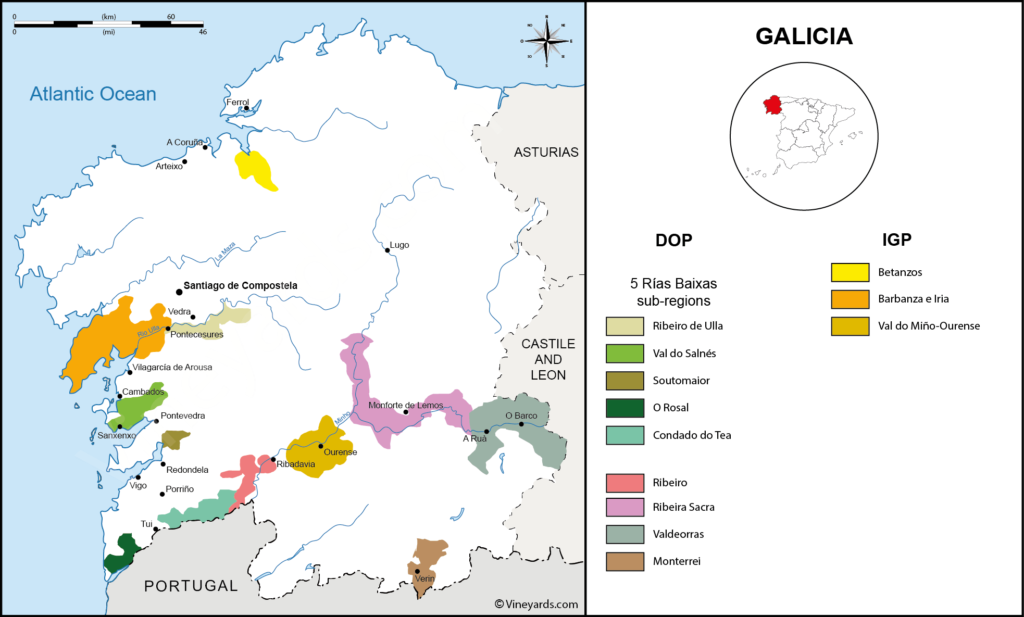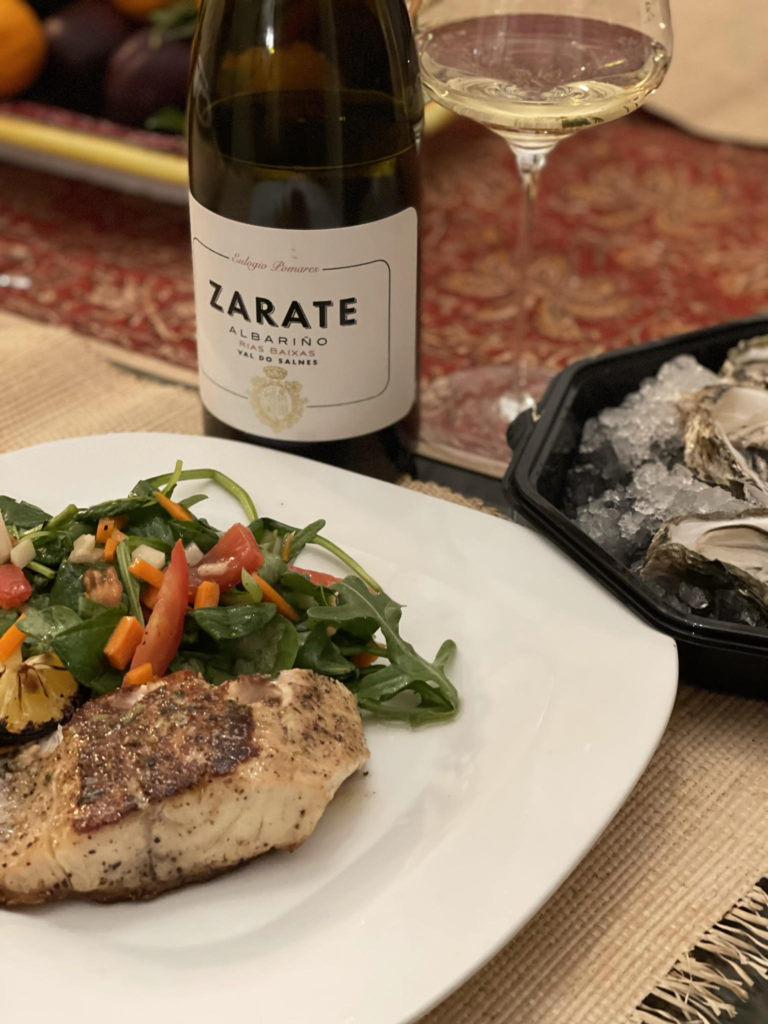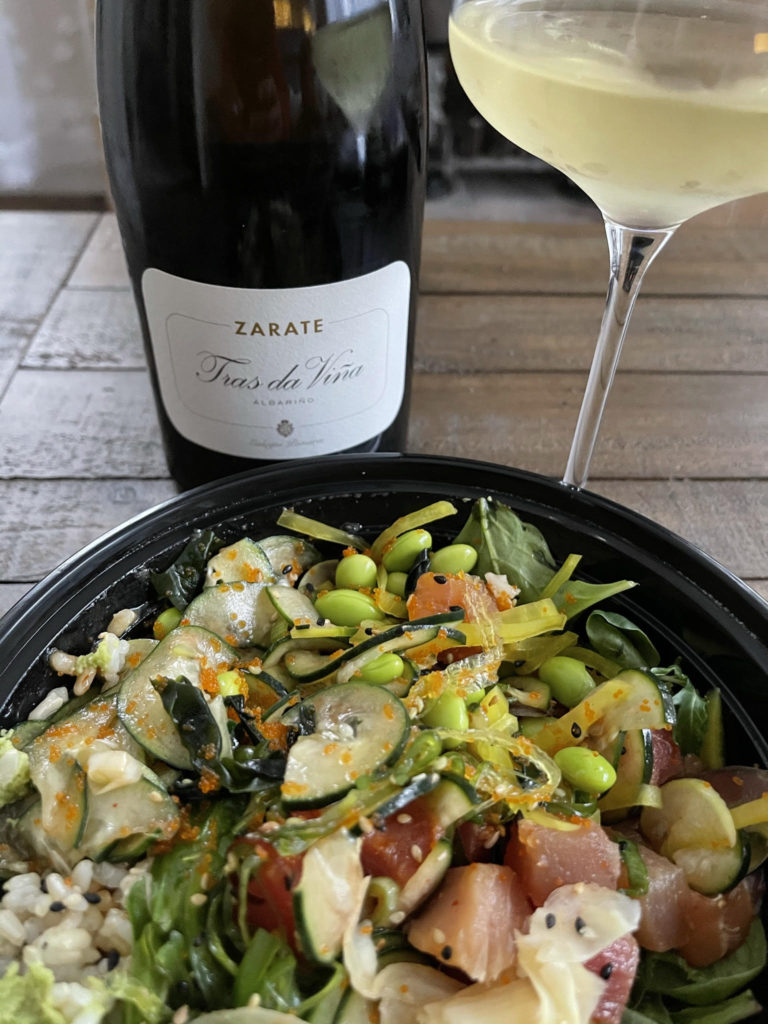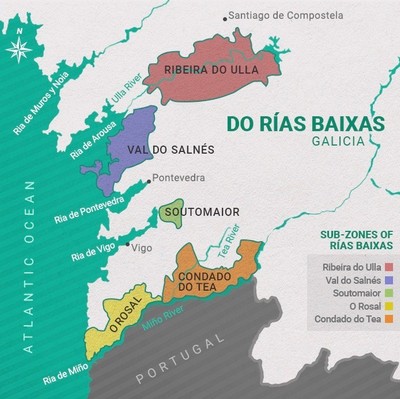As remarkable as the high quality and originality of Eulogio’s wines are, the most extraordinary aspect to his approach is his use of natural viticulture…
Importer, Rare Wine Co
This month the intrepid #WorldWineTravel group of bloggers continues its 2021 virtual exploration of Spain with a visit to Galicia.

Located in North-West Spain on the Atlantic Ocean coast, Galicia, is part of “Green Spain”, so called because of its cool, wet climate, misty marine layer and verdant rolling hills. It is home to five DO-rated wine zones. Running west to east they are: Ribeiro, Ribeira Sacra, Monterrei, Valdeorras and the most renowned, Rias Baixas, which is the focus of this piece.
About Rias Baixas
Rías Baixas (Galician for “Lower Rias,” and refers its four estuaries) is located on the southwestern coast of Galicia above Portugal. It earned DO status in 1988. While the region is now renowned for white wine (over 99% of Rias Baixas wines are white), in the early 20th century, production was 95% red and only 5% white!
The region’s first winemakers are believed to have been the Romans, whose occupation of the surrounding Galicia region brought trade, technology and viticulture. More refined winemaking was introduced by Cistercian monks who arrived from France in the 12th century. Some believe it the French monk who introduced the Albariño to the region, but the prevailing theory is the it is native to Rías Baixas. Wine production in Galicia and Rías Baixas flourished in the 14th and 15th centuries, and it continued to expand through the 19th century before a series of circumstances (among them Phylloxera, and trade wars) lead to its decline.
During the replanting of hybrid and native Spanish varieties in the early 20th century, Albariño began to emerge as the region’s star, showing its potential to produce high quality wines in the hands of a new generation of skilled winemakers. (Source)
Rías Baixas is divided into five separate terroir-based sub-regions: Ribeira do Ulla, Val do Salnés, Soutomaior, Condado do Tea and O Rosal. For details of each of the sub-zones click here.
There are 14 permitted grape varieties are permitted in the DO, but white Albariño grape represents 96% of all plantings.
DO Rías Baixas permits eight types of wines:
- Rías Baixas
- Rías Baixas Albariño –100% Albariño, grapes can be sourced from any sub-zone
- Rías Baixas Salnés
- Rías Baixas Condado
- Rías Baixas Rosal
- Rías Baixas Barrica – wines aged in oak, can be red or white
- Rías Baixas Tinto – red wine, less than 1% of all production
- Rías Baixas Espumoso – sparkling wine, limited production
While the vast majority of the region’s wines are produced on an industrial scale in the “traditional” style – refreshing, tank-fermented wines intended for early consumption (and rightfully so I might add; they are food friendly, delicious wines that don’t break the bank), there are a significant cadre of artisan producers who pushing boundaries and seeking to expand the region’s expressive possibilities by crafting more complex age-worthy Albariño.
In My Glass
2019 Zarate Albariño Rías Baixas Val do Salnés
This is Bodegas Zarate’s “entry-level” (or in my case “gateway”) wine. Fruit for this wine is sourced from estate vineyards averaging around between 35-40 years. Fermented on wild yeast, it is aged in tank for 6 months on its fine lees before bottling with around 15-30% of the wine completing malolactic fermentation.

My tasting notes follow:
Brilliant pale gold color with guava, lemon, dried apricot, lemon blossom, and a hint of petrichor aromas. On the palate it’s medium-bodied and crisp with mouth-watering acidity with lemon and guava flavors accented with a very appealing saline minerality and a lengthy finish. 13% abv|SRP – $22|90pts. Going forward, anytime I have a conversation about my favorite Albariños, this one will be part of that conversation.
It was wonderful paired with Sautéed Striped Bass With Lemon and Herb Sauce + Raw Oysters
It was my intent to write about one of the Zarate wines, but I was so enamored with the “entry level” bottling, I quickly purchased a couple of bottle of one of their single vineyard offerings….
2018 Zarate Albariño Rías Baixas Tras da Viña
Fruit for this wine is sourced for the Tras da Viña vineyard, a south-facing site planted in 1970 with cuttings from El Palomar (planted in 1850). Its soils of decomposed yellow granite and a bit richer than other site on the estate. Fermented on wild yeast, this cuvée typically goes through partial malolactic fermentation and spends about 24 months on the lees.

My tasting notes follow:
Pale golden-yellow color with yellow apple, mixed citrus peel, beeswax, and ocean spray aromas. On the palate it’s full-bodied with a very appealing texture and fresh, mouth-watering acidity with yellow apple, a hint of green apple, honey, lemon-lime flavors complicate with a beautiful saline minerality and a long finish. 13% abv| SRP – $48.|92-93pts Whoa! This wine evokes Grand Cru Chablis for me!
It was wonderful paired with a take-out Poke bowl!
About Bodegas Zarate
Bodegas Zarate was founded in 1707. In 1850, they planted what is now Rias Baixas’ oldest documented pre-phylloxera Albariño vineyard called El Palomar, which still produces wine to this day. The Zarate estate is located in the Val do Salnés zone, encompasses a total of 9.6 Ha of vines, over 12 different parcels. It soils situated on undulating slopes of Xabre—weathered granite—soil. The combination of its soils, cool climate and close proximity to the ocean cool climate make it the region’s greatest terroir.
It was in 1953 that Ernesto Zárate initiated the Albariño Festival in Salnés’ capital of Cambados. Yet, he withdrew his wine from the festival’s competition three years later having won first prize each year, vowing not to re-enter until another grower had matched his accomplishment. To this day, no one has. (Source).
Today, seventh-generation Eulogio Pomares is at the helm of Bodegas Zarate. Pomares has reputation of being a perfectionist, who is also very much a student of other great wines of the Iberian Peninsula. He also finds inspiration from other great regions such as Barolo, Burgundy and Champagne.
As remarkable as the high quality and originality of Eulogio’s wines are, the most extraordinary aspect to his approach is his use of natural viticulture, a seemingly impossible feat in what is Spain’s coolest and wettest winegrowing region. (Source)
Pomares’ farming is almost fully biodynamic—he works the soil manually, uses cover crops for genetic diversity and makes his own biodynamic teas for vine and soil treatments. All new plantings are massale selections from the estate’s oldest vines.
In the cellar, the Zarate Albariños are fermented with native yeasts and aged sur lie. No sulfur is added during élévage, and at bottling he adds only a tiny amount as required for each wine’s stability.
But wait, there’s more Galicia goodness ahead. Be sure to check out what my fellow bloggers discovered during their virtual exploration of Galicia.
- Steve at Children of the Grape shares Troubadours, Love, and Wine.
- Terri at Our Good Life discusses One Grape: Three Unique Experiences with Albarino.
- Andrea at The Quirky Cork writes about Albariño and Bacon: A Love Affair.
- Lynn at Savor the Harvest recommends A Region and Wine You Must Explore: Rias Baixas and Albariño.
- Jeff from Food Wine Click! shares A Tale of Two Rias Baixas Albarinos.
- Wendy from A Day in the Life on the Farm talks about My Virtual Trip to Rias Baixas.
- Allison and Chris at ADVineTURES discuss The White Wines of Rias Baixas.
- Nicole from Somm’s Table shares It’s Raining Rias Baixas.
- Camilla at Culinary Adventures with Camilla pairs Sopa de Cebolla + 2020 Fillaboa Albariño.
- Martin from ENOFYLZ Wine Blog talks about Bodegas Zarate; Setting the Standard for Rias Baixas Albarino – Then and Now.
- David at Cooking Chat pairs Pan Seared Sea Bass with Albariño.
- Jennifer at Vino Travels shares Refresh Your Palate with Rias Baixas Albarino.
- Melanie from Wining with Mel takes a Wine Romp Through Rias Baixas in Galicia, Spain.
- Rupal from Syrah Queen has Your Passport To Rias Baixas – Explore Three Incredible Albarinos.
- Susannah at Avvinare posts Rias Baixas – Green Spain Entices.
- Gwendolyn from Wine Predator shares From California’s Camino Real to Galicia’s Camino de Santiago: All Aboard for Albariño 2!
- Liz at What’s In That Bottle? says Pack Your Bags: We’re off to Rias Baixas for an Albariño Adventure.
- Linda, your host, from My Full Wine Glass offers 5 Things that Might Surprise You About Rías Baixas, Home of Albariño.
You’re invited to join the World Wine Travel bloggers Saturday, April 24, at 8 am PT/11 am ET, for a live Twitter chat about this corner of Spain. No need to have published a post – an interest in learning and sharing will suffice. Simply follow the #WorldWineTravel hashtag.

We are familiar with this producer and have had the Val do Salnés but not the Tras da Viña. Given your ratings, we need to find some stat!
I will have to keep an eye out for some Zarate wines. Did I mention to you that they are opening a Total Wine store not too far from me. You first introduced me to Total Wines years back when I was looking for a wine in the SF area and you sent me to one.
I do remember the Total Wine recommendation. I’m excited that there will be one near you soon!
I love me some straight up, no MLF Albariño but love that people are playing with different techniques and both of these Zarate wines sound like brilliant examples of exactly that! Love your notes on these.
Thanks Andrea…generally, I’m not a fan of MLF wines, but there (clearly) are exceptions from time to time;-)
Wow, you scored with this wine Martin. A friend of mine living in Galicia said Zarate when I asked about wines. I’m generally not a big fan of MFL wines but with the higher acidity levels betting it works to tone them down. One last note- oysters… yes!
The description of this wine has my mouth watering this morning, Martin. Wow. I, too, am not a huge fan of MLF wines either. But I would certainly love to try this one. Keeping my eyes. open now. Cheers.
Now I want to find a Zarate wine! And, as usual, I learn stuff from your blog and want to know more. Tell me about “lees” and what that means for wine. I have heard that mentioned a few times now. Yummy pairing, too!
These wines sound like such a great find. I will definitely be on the look out. Thanks for sharing all of the history as well!
That’s some high praise to compare this wine to a Grand Cru Chablis! I’m impressed that Zarate can go biodynamic in that wet climate. Such a role model!
Love Albarino! Found some new wines to try and places to visit! Keep up the informative pieces. As a somm, I am always up for reading more. Check out my upcoming Jeep wine touring business in Sonoma:
https://www.vinesofsonoma.com
Thanks for stopping by and the kind words Jeff. Will check out your website!